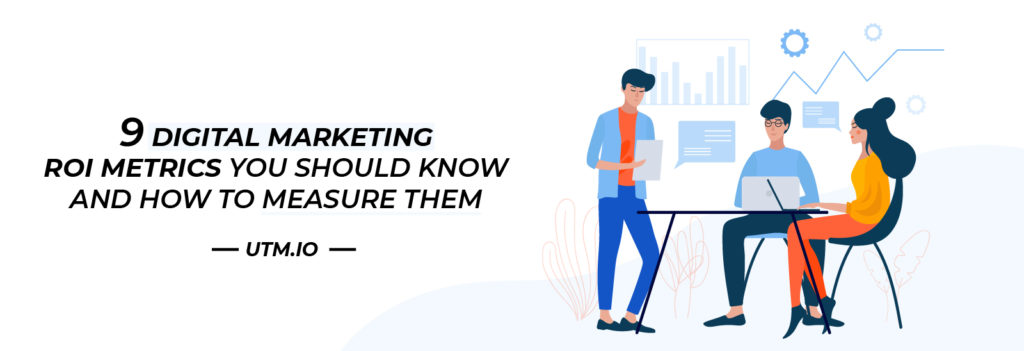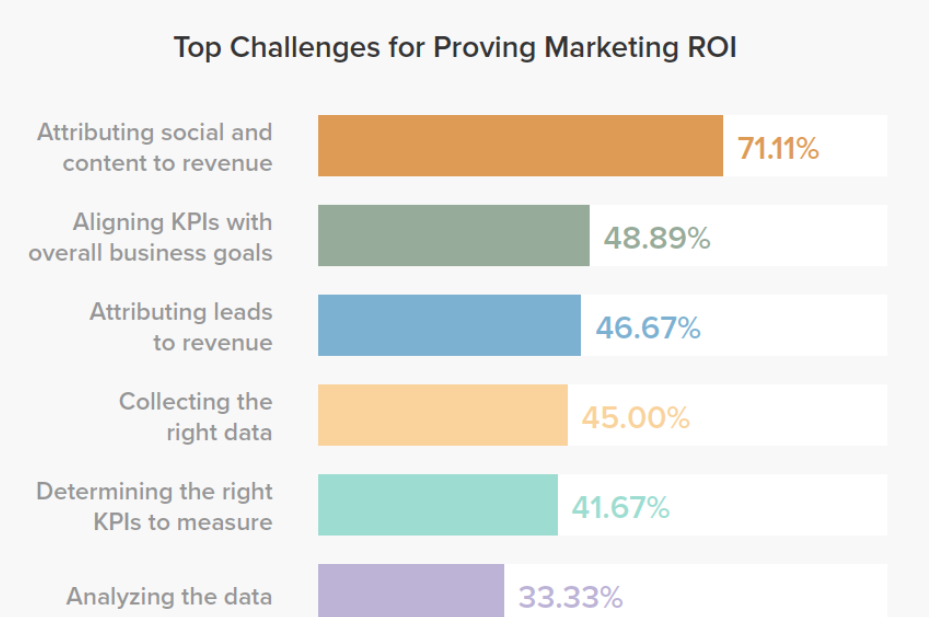Proving the ROI of digital marketing is one of the biggest challenges faced by marketers today. In fact, a recent research report suggests that ~47% of marketers find it difficult to attribute leads to revenue and ~42% don’t know the right metrics to measure performance.
Image Source: TrackMaven
This is a big problem. If you can’t determine the ROI of your efforts, you won’t be able to plan your future strategy.
That’s why we have compiled a list of 9 metrics that you should track to measure the ROI of digital marketing.
1. Unique Monthly Visitors
As the name suggests, this metric tells you how many different people visited your website in a month. As a lot of digital marketing tactics aim to generate more website traffic, this is one of the basic metrics that you can track.
An increase in monthly visitors after running a digital marketing campaign can be, in part, attributed to it. This can be considered as a sign that your campaign was successful if you got the desired increase in unique monthly visitors.
You can track this metric directly from your Google Analytics account or any other website analytics tools that you use.
2. Traffic Generated by Channel
Another useful metric for measuring the ROI of your digital marketing efforts is to analyze the traffic generated by different sources. This will give you an idea of which channels or initiatives are driving the most traffic.
For example, if you are getting the most traffic from organic searches, you’d know that your SEO efforts are paying off. Or, if referral traffic is your key source of traffic, then probably it’s content marketing and link building that’s working for you.
You can find the data on traffic generated from different sources from Google Analytics.
3. Cost Per Lead
Cost per lead (CPL) is an important metric that can be used to measure your digital marketing ROI. In simple terms, cost per lead refers to the investment you made to generate a lead.
For your ad campaigns, you can track this metric directly using Google AdWords or social media advertising platforms. For AdWords, this metric is called, “cost per conversion.” You can also calculate CPL by dividing total ad spend by total attributed leads.
This metric is usually associated with paid campaigns as you don’t exactly pay to get organic traffic. However, it can be applied to other digital marketing initiatives as well, as they indirectly contribute to lead generation. You can calculate it as the total investment in a campaign divided by the leads generated by it.
For example, if you’re running an email campaign and want to know the cost per lead, you can use UTM parameters to track the leads first. You can use UTM.io to add UTM parameters to all the links in your emails. These will help you track exactly which emails generated a particular lead. You can then calculate the CPL by dividing the email marketing spend by the number of leads generated by your emails.
4. Cost Per Acquisition
Cost per acquisition (CPA) is similar to the cost per lead metric, with the only difference being that it focuses on actual conversions and not just leads. CPA is essentially the cost to acquire a customer and is easier to calculate for paid campaigns than for SEO initiatives.
On an overall level, it can be calculated by your total digital marketing spend divided by the total number of customers acquired during a certain duration.
5. Customer Lifetime Value
Customer Lifetime Value (CLV) is an important metric that almost all types of businesses should calculate. This is especially beneficial for ecommerce companies as it gives them an estimate of how profitable a customer may be in the long term.
This metric tells you whether what you spend on acquiring a customer is even worth it. For example, if you acquire a customer for $X and they end up making only one purchase of $X or less. In this case, the customer lifetime value is $X as they are not likely to make a repeat purchase. And, therefore, the money spent on acquiring that customer is not worth it.
There is no direct way of finding out customer lifetime value and each business has its own methodology for making projections and estimates.
6. Conversion Rate
We all know that identifying traffic sources or channels is a good way to identify what works for a particular business. However, traffic in itself is not a very reliable metric. After all, what matters most is what percentage of the traffic generated actually converts into paying customers.
That’s why expert marketers prefer using conversion rate as their preferred metric to determine digital marketing ROI. You can calculate this by analyzing what percentage of traffic generated by a channel actually converted.
One channel might be generating more traffic than another, but it may not be driving conversions. Another channel might be bringing in less traffic, but most of that traffic results in conversions. As a business, you should focus your efforts on the latter channel as it’s the one getting more conversions.
7. Return on Ad Spend
Return on Ad Spend is a metric that directly tells you the ROI of your advertising campaigns. Unlike other digital marketing techniques, where it is difficult to calculate ROI, with paid campaigns, you can easily find your ROI.
Return on Ad Spend directly ties revenue to the costs of running a paid campaign. It is calculated as the total revenue generated via your ad campaign divided by the total ad spend.
If you run ad campaigns, then this is one digital marketing ROI metric that you can’t afford to overlook.
8. Landing Page Performance Metrics
There are several metrics that determine how your landing pages are performing. And, as landing pages are crucial in driving leads down the funnel, it is important for you to track these metrics.
Here are some landing page metrics that you should regularly track and measure.
Bounce Rate
This refers to the share of website visitors who leave after visiting just one page, without moving to other pages. This is basically a measure of stickiness and this metric is available on Google Analytics. The lower the bounce rate, the better it is for your business.
Time Spent on Page
This metric helps you assess the effectiveness of your landing page design and content to engage your audience. You can find this directly in your Google Analytics data.
The more time your users spend on your landing pages, the better are the chances that they will move on to another page and not exit. Therefore, your landing pages need to be able to hold users’ attention long enough to direct them to another page.
Conversions or Conversion Assists
Landing pages are designed to direct website visitors down the sales funnel by taking the desired actions. You landing page CTAs can direct users to a service or product page or for signing up for something or any other desired action.
The more people who click on CTAs, the better.
You can track these conversions or conversion assists by tracking the number of people who clicked on your landing page CTAs.
9. Keyword Average Ranking
This indicates the average ranking that you get on the search engines for your targeted keywords. The higher your ranking, the more organic traffic you’ll get. Which eventually leads to conversions. Therefore, this is also an important digital marketing ROI metric that you should regularly track using a SERP tracker and try to improve on.
Conclusion
These 9 metrics are important for you to track and they can help you measure your digital marketing ROI. You can use them to assess whether your initiatives are getting the desired results or not.
If you have any queries regarding these digital marketing ROI metrics, feel free to ask us in the comments section.


Informative article! Clear explanations of digital marketing ROI metrics and the importance of setting goals for better results.